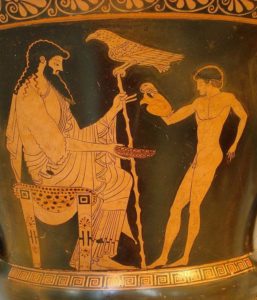 We’re not seriously suggesting that Ganymede is the sort to serve as patron saint of anything (putting some clothes on might be a step in the right direction), but if contemporary sommeliers were to do a serious search for the roots of their profession as wine service experts, the beautiful boy at left who became cupbearer to Zeus could at least provide a useful prototype. He clearly had style and a good deal of personal charm. But there was work to be done, and he must have been good at it — Olympic quality, you might say.
We’re not seriously suggesting that Ganymede is the sort to serve as patron saint of anything (putting some clothes on might be a step in the right direction), but if contemporary sommeliers were to do a serious search for the roots of their profession as wine service experts, the beautiful boy at left who became cupbearer to Zeus could at least provide a useful prototype. He clearly had style and a good deal of personal charm. But there was work to be done, and he must have been good at it — Olympic quality, you might say.
In the ancient Mediterranean world, putting a saucer of wine into a guest’s hands was a complicated business. For starters, there was the matter of getting the wine out of the (large, heavy, fired clay) amphora in which it was stored. Since wine was never drunk neat, it had first to be mixed with water in carefully calculated proportions inside large urn-like vessels and only then drawn with a pitcher and served out.
What we have less evidence of is the degree to which an ancient somm-equivalent would be expected to give an account of the provenance of the wine, its constituent varietals, the circumstances of the vintage, and the character of the folks responsible for it. It’s the kind of context-building narration we’ve grown accustomed to at establishments that are serious about their wine programs and execute them with admirable energy and evident joy.
The uptick in this sort of behavior is consonant with the current interest in the world of small-production, naturalist winemaking – and we welcome it. But performing on wine’s version of talk radio is no excuse for overlooking some fundamental aspects of service any Ganymede wannabe would have understood.
One suggestion: More attention to serving temperatures Whites and rosés are still routinely poured far too cold, reds too warm. With naturalist vintners now giving us a far greater spectrum of color, weight, tannin, and extract, restos and wine bars need to respond by tailoring serving temps to each wine they pour. It’s time we recognized that missing the mark here can obviate a shocking amount of thoughtful winemaking.
Another: It’s well understood that natural wines are desperate for oxygen and need a good splashy, aerating decant to be what they were meant to be – but decanting is not routine at the most fervently naturalist venues. Because of this, consumers are getting the idea that natural wine is essentially stinky and reductive. Not true, but we can hardly blame them for coming to that conclusion since we’re leading them to it.
Seems to us it’s time somms did some catching up with current wine reality. Or are we mything something?
Taste, talk and learn about wine his week in the FKC wine corner . . .
THURSDAY, SEPT 5 3-6 PM – ADMIRABLE ENERGY
2018 Poderi Sanguineto, Toscana Bianco, $19.95 (new vintage)
2015 Lamé Delisle Boucard Bourgueil “Cuvée Prestige,” $18.95
2015 Château Unang, Ventoux, $19.95
FRIDAY, SEPT 6 3-6 PM – EVIDENT JOY
2017 Gini, Soave Classico, $21.95
2018 Domaine Les Fouques, Côtes de Provence Rosé “La Londe,” $24.95
2017 Château de Lavernette, Beaujolais-Villages, $24.95
TAKE 10% OFF ANY 6 WINES LISTED HERE THROUGH WEDNESDAY, SEPTEMBER 11